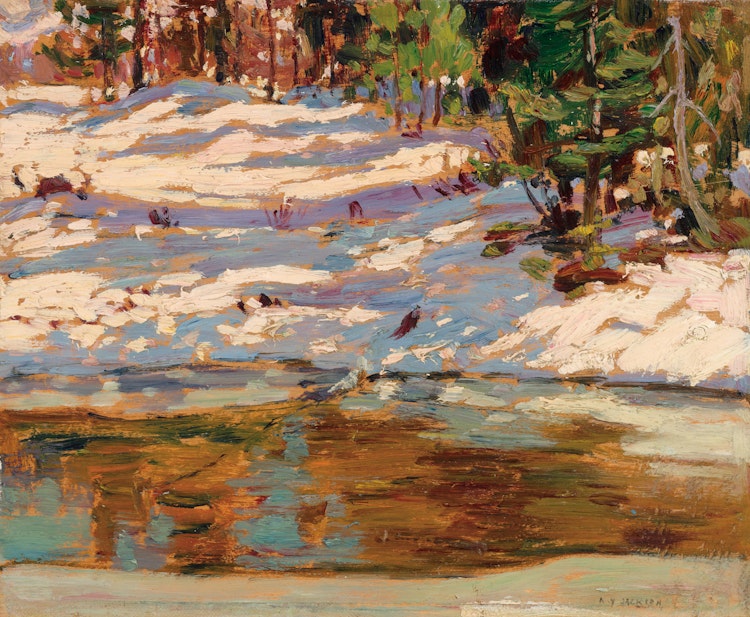Reflections in the Creek, circa 1914 by Alexander Young Jackson

A.Y. Jackson
Reflections in the Creek, circa 1914
oil on panel
signed lower right; signed on a March 1970 label on the reverse
8.5 x 10.5 in ( 21.6 x 26.7 cm )
Auction Estimate: $20,000.00 - $30,000.00
Price Realized $31,200.00
Sale date: May 28th 2025
Roberts Gallery, Toronto
Joyner Waddington's, auction, Toronto, 1 June 2010, lot 68
Private Collection, Toronto
A.Y. Jackson, "A Painter's Country: The Autobiography of A.Y. Jackson", Toronto/Vancouver, 1958, page 35
Wayne Larsen, "A.Y. Jackson: The Life of a Landscape Painter", Toronto, 2009, pages 63, 64
Jackson’s travels into Algonquin Park was inspired by the stories and artworks of Tom Thomson. Eager to experience it for himself, Jackson set off alone to traverse the frozen north in February of 1914. Exhilarated by the rugged Canadian wilderness, this trip proved to be a great success for Jackson. "Reflections in the Creek" showcases Jackson’s skill of dynamic layering, where the thick white paint of the heavy snow is momentarily interrupted by tufts of grass. Bathed in sunlight, the partially hidden forest is brought to life under Jackson’s brush. Long shadows cast onto the snow are stretched across the board, while dense brush is reflected in the still creek below.
Share this item with your friends
Alexander Young Jackson
(1882 - 1974) Group of Seven, Canadian Group of Painters, OSA, RCA
Born in Montreal, Alexander Young Jackson left school at the age of twelve and began work at a Montreal printing firm. In 1906, he undertook art studies at the Art Institute in Chicago. The following year he enrolled at the Académie Julian where he studied under Jean Paul Laurens for six months, then he travelled to Italy with others where they visited galleries in Rome, Florence and Venice. They returned to France and Jackson went to the village of Episy with a fellow student named Porter with whom he had lived in Paris. Jackson found much to paint at Episy: old farms, rolling country, the canal where barges were towed by mules, and for the first time (in France) he lived with people close to the land.
He left France when his funds were low and returned to Canada in 1910 where the “clear crisp air and sharp shadows” of Sweetsburg, Quebec, became the subject of his canvas “Edge of the Maple Wood”. During this period his painting was strongly influenced by the Impressionists. Then the work of Canadian artists Cullen and Morrice led him further in the discoveries of snow and other elements of Canadian subject matter which were to become an integral part of his work throughout his life. After his return to Canada, Jackson took up residence in Montreal and made many sketching trips to the surrounding countryside. While at Emileville he received a letter from a J.E.H. MacDonald of Toronto who wanted to purchase his “Edge of the Maple Wood” on behalf of a third party, Lawren Harris. Jackson sold the picture and later met MacDonald in Toronto. In Toronto he also met, through MacDonald, Arthur Lismer, Frederick Varley and other members of the Arts and Letters Club who were employed by the Grip Engraving Company as commercial artists. Jackson later went to Georgian Bay to sketch and was visited there by Dr. James MacCallum, a friend of Lawren Harris. MacCallum, who had a summer home at the Bay, offered Jackson a place to work in the ‘Studio Building’ which MacCallum and Lawren Harris were having built for Canadian artists in Toronto. In the meantime Jackson was invited to stay at MacCallum’s summer home. Jackson’s production was good; he did many sketches and a number of canvases, one being the “Maple in the Pine Woods” which was later to bring a storm of criticism at a Group of Seven exhibition.
On his return to Toronto, Jackson stayed at Lawren Harris’ studio in Toronto until the Studio Building was completed. There one day he was introduced to Tom Thomson who had accompanied Dr. MacCallum on a visit. Thomson was also an employee of the Grip Engraving Company. The two moved into the Studio Building in January 1914 and shared a studio. Thomson had soon inspired Jackson to visit Algonquin Park in February and March of 1914. Jackson also sketched that year with J.E.H. MacDonald and J.W. Beatty. In 1915, Jackson enlisted as a private in the 60th Battalion and after being wounded, returned later to the front as Lieutenant with Canadian War Records. As a war artist he created one of the finest collections of war paintings our nation possesses.
In 1919 he went to Algoma with J.E.H. MacDonald, Lawren Harris and Franz Johnston, making use of a railway box car as a studio which Harris had arranged. During that year, Jackson became a full member of the Royal Canadian Academy. On May 7th, 1920, the first exhibition of the Group of Seven opened at the Art Gallery of Toronto. The Group continued to exhibit until 1931. Each exhibition of the Group was met with great protest. In July of 1927 Jackson and Dr. Frederick Banting went north on the steamer ‘Beothic’ which had been chartered by the government to deliver supplies to the RCMP posts and to carry relief constables to the posts. They sketched at Pond Inlet, Devon Island, Ellesmere Island and other arctic locations. Jackson’s arctic sketches were exhibited at the Art Gallery of Toronto.
Jackson's great sense of adventure carried him from the east coast across Canada to the Rocky Mountains of the west. He made regular sketching trips to Quebec every spring and travelled to the far regions of Canada during the summer, including the Canadian Arctic. In the fall he would return to the Studio Building in Toronto (where he lived until 1955), spending the winters painting canvases. He continued this active lifestyle until he was in his eighties.
Source: "A Dictionary of Canadian Artists, Volume II”, compiled by Colin S. MacDonald, Canadian Paperbacks Publishing Ltd, Ottawa, 1979

